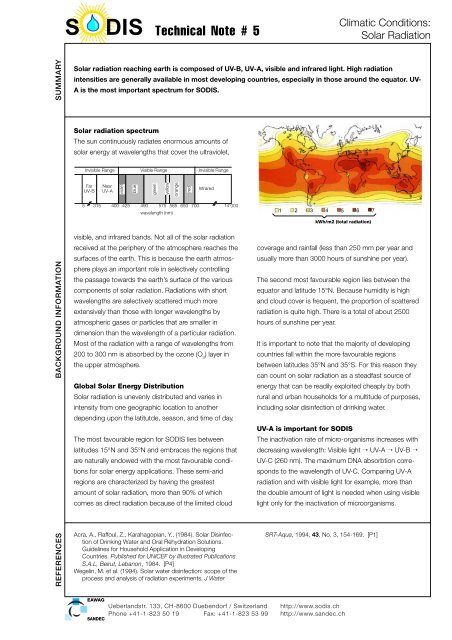Technical Notes
Technical Notes
Technical Notes
- No tags were found...
You also want an ePaper? Increase the reach of your titles
YUMPU automatically turns print PDFs into web optimized ePapers that Google loves.
S DIS <strong>Technical</strong> Note # 5Climatic Conditions:Solar RadiationBACKGROUND INFORMATION SUMMARYSolar radiation reaching earth is composed of UV-B, UV-A, visible and infrared light. High radiationintensities are generally available in most developing countries, especially in those around the equator. UV-A is the most important spectrum for SODIS.Solar radiation spectrumThe sun continuously radiates enormous amounts ofsolar energy at wavelengths that cover the ultraviolet,Invisible RangeFarUV-BNearUV-AvioletblueVisible Rangegreen5 315 400 425 490 575 585 650 700 14'000wavelength (nm)visible, and infrared bands. Not all of the solar radiationreceived at the periphery of the atmosphere reaches thesurfaces of the earth. This is because the earth atmosphereplays an important role in selectively controllingthe passage towards the earth’s surface of the variouscomponents of solar radiation. Radiations with shortwavelengths are selectively scattered much moreextensively than those with longer wavelengths byatmospheric gases or particles that are smaller indimension than the wavelength of a particular radiation.Most of the radiation with a range of wavelengths from200 to 300 nm is absorbed by the ozone (O 3) layer inthe upper atmosphere.Global Solar Energy DistributionSolar radiation is unevenly distributed and varies inintensity from one geographic location to anotherdepending upon the latitutde, season, and time of day.The most favourable region for SODIS lies betweenlatitudes 15°N and 35°N and embraces the regions thatare naturally endowed with the most favourable conditionsfor solar energy applications. These semi-aridregions are characterized by having the greatestamount of solar radiation, more than 90% of whichcomes as direct radiation because of the limited cloudyelloworangeredInvisible RangeInfrared1 2 3 4 5 6 7kWh/m2 (total radiation)coverage and rainfall (less than 250 mm per year andusually more than 3000 hours of sunshine per year).The second most favourable region lies between theequator and latitude 15°N. Because humidity is highand cloud cover is frequent, the proportion of scatteredradiation is quite high. There is a total of about 2500hours of sunshine per year.It is important to note that the majority of developingcountries fall within the more favourable regionsbetween latitudes 35°N and 35°S. For this reason theycan count on solar radiation as a steadfast source ofenergy that can be readily exploited cheaply by bothrural and urban households for a multitude of purposes,including solar disinfection of drinking water.UV-A is important for SODISThe inactivation rate of micro-organisms increases withdecreasing wavelength: Visible light → UV-A → UV-B →UV-C (260 nm). The maximum DNA absorbtion correspondsto the wavelength of UV-C. Comparing UV-Aradiation and with visible light for example, more thanthe double amount of light is needed when using visiblelight only for the inactivation of microorganisms.REFERENCESAcra, A., Raffoul, Z., Karahagopian, Y., (1984). Solar Disinfectionof Drinking Water and Oral Rehydration Solutions.Guidelines for Household Application in DevelopingCountries. Published for UNICEF by Illustrated PublicationsS.A.L, Beirut, Lebanon, 1984. [P4]Wegelin, M. et al. (1994). Solar water disinfection: scope of theprocess and analysis of radiation experiments. J WaterSRT-Aqua, 1994, 43, No. 3, 154-169. [P1]Ueberlandstr. 133, CH-8600 Duebendorf / Switzerland http://www.sodis.chPhone +41-1-823 50 19 Fax: +41-1-823 53 99 http://www.sandec.ch
















